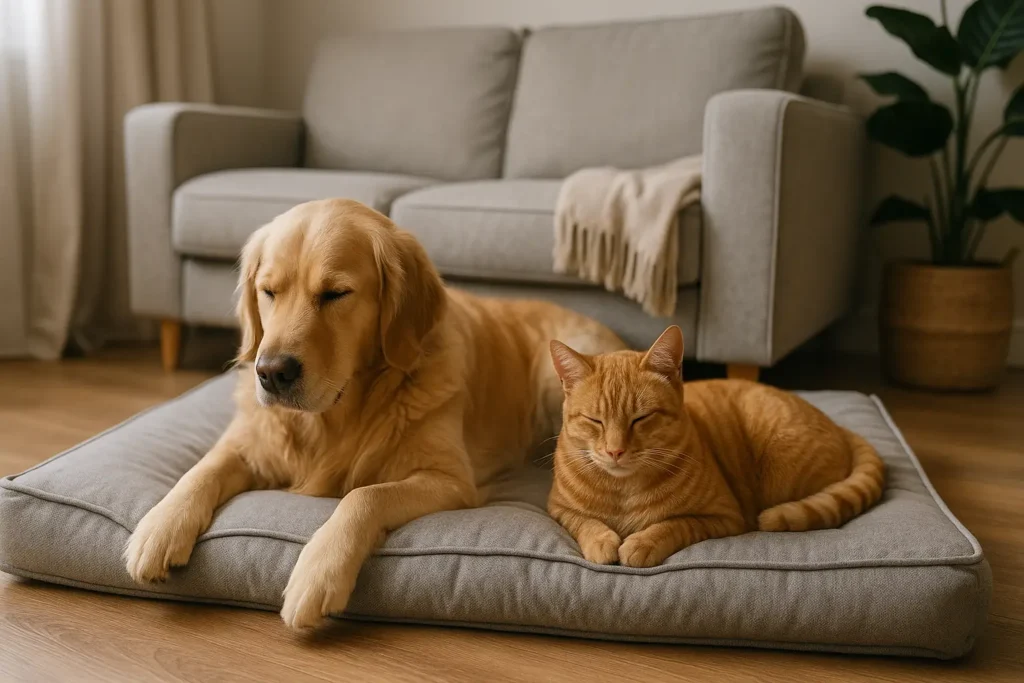How to Create a Calm and Safe Environment for Your Dog or Cat at Home
Your home is more than just a place to live—it’s the heart of your pet’s entire world. Every sound, smell, object, and interaction shapes their daily experience. That’s why creating a calm and safe environment for pets is one of the most powerful things you can do to support their happiness and health.
Whether you have a playful puppy, a shy rescue cat, or an aging senior pet, the way you design their physical space and emotional atmosphere can dramatically affect their behavior, trust, and quality of life.
In this guide, we’ll explore practical steps to turn your home into a sanctuary—where your dog or cat feels protected, peaceful, and at ease every single day.

Why a Calm Environment Matters
Just like people, pets are sensitive to their surroundings. A chaotic or unpredictable environment can cause chronic stress, which impacts both physical and mental health.
Effects of a Chaotic Environment:
- Increased anxiety or hyperactivity
- Destructive behaviors
- Difficulty sleeping or relaxing
- Increased aggression or fearfulness
- Weakened immune response
On the other hand, a calm environment for pets fosters emotional balance, better behavior, and deeper trust with their humans.
Step 1: Designate Safe Zones
Every pet needs a personal space where they feel completely secure—a space where they can retreat, rest, and feel protected from overstimulation.
For Dogs:
- Crate with soft bedding and calming cover
- Quiet corner with blankets and toys
- Bed in a low-traffic room
For Cats:
- Hideaway beds, cat caves, or cardboard boxes
- Access to vertical spaces (shelves, perches)
- Quiet windowsills with outdoor views
Avoid placing beds or crates near loud appliances, walkways, or doors. Your pet should feel they can truly “clock out” in peace.
Step 2: Reduce Loud or Sudden Noises
Loud environments make pets feel unsafe, especially cats or anxious dogs.
Noise-Reducing Tips:
- Use white noise machines or calming music
- Avoid sudden yelling or door slamming
- Use rugs and curtains to absorb echoes
- Keep TVs and radios at a low volume
- Mute alerts on phones and appliances
Try to maintain a consistent noise level in your home. Predictability builds emotional safety.
Step 3: Control Lighting and Visual Stimulation
Bright, flickering, or unpredictable lighting can make pets feel agitated—especially at night.
Best Practices:
- Use soft, warm lighting in resting areas
- Dim lights in the evening to support natural sleep cycles
- Avoid strong overhead lights in pet zones
- Use blackout curtains for pets sensitive to outdoor activity or headlights
Natural light during the day is ideal—but offer shade options so pets can choose their comfort.
Step 4: Use Calming Scents (Safely)
Pets are incredibly scent-sensitive. The right smells can support relaxation—while the wrong ones cause distress.
Safe Calming Scents:
- Lavender (in pet-safe diffusers)
- Chamomile
- Frankincense
- Pheromone sprays (Feliway for cats, Adaptil for dogs)
Avoid:
- Strong essential oils (especially tea tree, citrus, eucalyptus)
- Chemical air fresheners or sprays
- Bleach and harsh cleaning products
Always ventilate spaces well and test new scents gradually.
Step 5: Choose Comforting Textures
Soft, familiar textures can create a deep sense of safety.
Ideas:
- Plush beds or fleece blankets
- Memory foam mats (especially for senior pets)
- Soft carpet runners on slippery floors
- Favorite fabric items (like a worn shirt with your scent)
Provide multiple options—some pets prefer cool surfaces like tile or hardwood during warm weather.
Step 6: Manage Household Traffic and Energy
The pace and energy of your household affect your pet’s emotional state.
Tips:
- Keep high-energy activities (kids’ playtime, workouts) in separate rooms
- Maintain calm energy during greetings and departures
- Encourage visitors to greet pets slowly and at their level
- Avoid overwhelming your pet with back-to-back guests or events
A calm human energy supports a calm pet.
Step 7: Create Visual Boundaries
Open spaces may overwhelm some pets—especially shy cats or nervous dogs. Use visual boundaries to help them feel more secure.
Tools:
- Baby gates to limit room access
- Furniture arrangement that creates corners or privacy
- Covered crates or canopies
- Room dividers or curtains
Visual separation helps pets feel they can observe without being in the center of activity.
Step 8: Use Routine to Create Safety
Routine is one of the most calming forces in a pet’s life. It teaches them what to expect and when—eliminating anxiety caused by unpredictability.
Build Routine Into:
- Feeding times
- Walks and play sessions
- Rest and sleep hours
- Social interactions
- Training or enrichment
Even small daily rituals (like saying “goodnight” or “time to eat”) give your pet emotional anchors.
Step 9: Minimize Rearranging and Clutter
Constantly changing furniture or cluttered spaces can confuse or stress pets—especially cats and seniors.
Tips:
- Keep beds, litter boxes, and feeding stations in consistent locations
- Avoid blocking walking paths
- Reduce clutter in areas pets frequent
- Introduce new items slowly and let pets explore on their terms
Familiarity creates calm. Even decor updates should be gradual.
Step 10: Provide Enrichment Without Overstimulation
Mental stimulation is vital, but too much excitement can backfire.
Balance active enrichment (toys, training, games) with calm recovery time.
Ideas:
- Rotate toys weekly to maintain novelty
- Use puzzle feeders with low-difficulty levels
- Offer chew toys or safe bones during quiet time
- Play soft music during solo enrichment
Let your pet decide when they’re “done”—don’t push activities past their comfort zone.
Step 11: Respect Boundaries and Signals
The best environment honors your pet’s emotional and physical boundaries.
Look for:
- Turning away
- Tail tucking or tail flicks
- Ears back or low posture
- Yawning or licking lips (stress signs)
If your pet seeks solitude, don’t pursue interaction. The ability to say “no” builds long-term trust.
Step 12: Offer Comfort During Stressful Events
When stressful events are unavoidable (guests, storms, fireworks), prepare a calming response.
Before the event:
- Set up a familiar “safe room”
- Use white noise or calming music
- Offer scent items and favorite toys
During:
- Stay calm and speak softly
- Avoid punishing stress behaviors
- Allow retreat without guilt
- Stay close if comfort is desired
After:
- Resume normal routine
- Reward calm behavior gently
Being emotionally available is more important than “fixing” the fear.
Step 13: Tailor the Environment to Life Stages
Age affects how your pet experiences their environment.
Puppies and Kittens:
- Need safe exploration zones
- Benefit from clear boundaries and supervision
- Prefer soft, warm bedding near humans
Adults:
- Need a mix of activity and recovery space
- Appreciate structured routines
- May benefit from moderate environmental change
Seniors:
- Need fewer stairs or slippery surfaces
- Prefer warmth, softness, and quiet
- Need easier access to water, beds, and litter boxes
Adapt your space as your pet evolves over time.
Step 14: Be Present Without Pressure
Calm doesn’t mean ignoring your pet—it means showing up with stillness and patience.
Try:
- Sitting nearby while they rest
- Reading aloud in their favorite room
- Offering hand contact without forcing
- Breathing slowly while petting them
Your peaceful presence becomes a calming anchor.
Step 15: Create a Sleep Sanctuary
Quality sleep is essential for emotional and physical health.
Tips:
- Use a designated bed in a low-light, quiet room
- Avoid loud alarms, bright screens, or heavy foot traffic nearby
- Keep temperature consistent and comfortable
- Offer nighttime rituals (brushing, soft words, music)
Pets need 12–16 hours of sleep daily. Protect this time with a peaceful environment.
Final Thoughts: Peace Starts at Home
Creating a calm environment for pets doesn’t require expensive gear or perfect silence. It requires empathy, observation, and consistency.
When your dog or cat knows they are safe—physically and emotionally—they can let go of hypervigilance, relax deeply, and connect with you fully.
You are the architect of their world. By choosing peace, you invite them to live not in fear or confusion, but in trust, balance, and love.




Post Comment